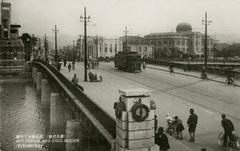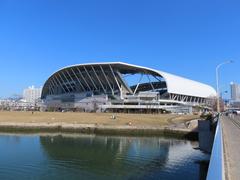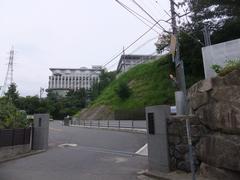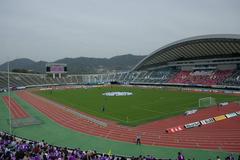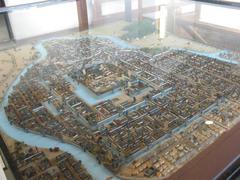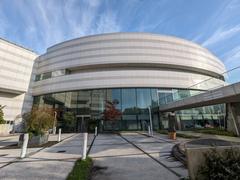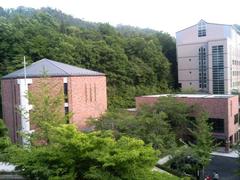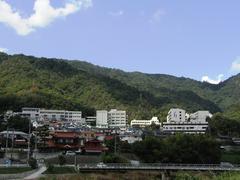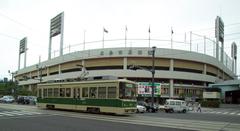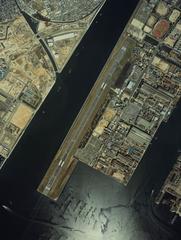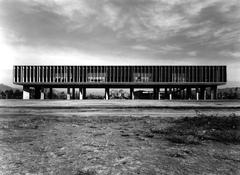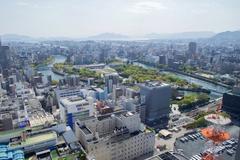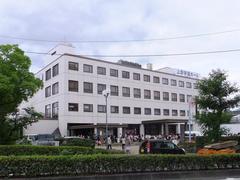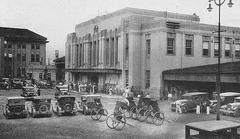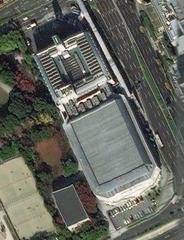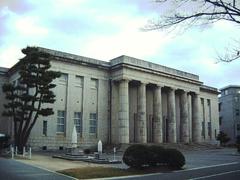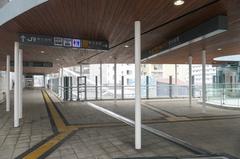Hiroshima Museum of Art: Visiting Hours, Tickets, and Guide to Hiroshima Historical Sites
Date: 15/06/2025
Introduction
Nestled in the heart of Hiroshima, the Hiroshima Museum of Art is a symbol of resilience, peace, and cultural renaissance. Established in 1978 to commemorate the centennial of the Hiroshima Bank, the museum embodies the spirit of Hiroshima’s recovery and its ongoing dedication to fostering hope and reconciliation through art. The museum’s architectural design—featuring a domed exhibition hall inspired by the Atomic Bomb Dome and corridors reminiscent of Itsukushima Shrine—reflects both the city’s tragic past and its enduring spiritual and cultural heritage.
The museum is celebrated for its outstanding collection of European modernism—especially French Impressionism and Post-Impressionism—with works by Monet, Degas, Renoir, van Gogh, Picasso, and more. Complementing these are notable Japanese paintings, including nihonga and yōga styles, showcasing the vibrant cultural exchanges that have informed modern Japanese art. Set within Hiroshima Central Park, the museum offers a tranquil retreat, surrounded by lush gardens and evocative sculptures, making it an ideal destination for art lovers, history enthusiasts, and anyone seeking peace and reflection (Hiroshima Museum of Art – Outline; Apollo Magazine; Peace Tourism).
Table of Contents
- Founding and Historical Context
- Architectural Symbolism and Design
- Collections and Artistic Focus
- Visiting Hours and Tickets
- Accessibility and Travel Tips
- Facilities and Amenities
- Special Events and Guided Tours
- Integration with Hiroshima Historical Sites
- Visitor Tips and FAQs
- Summary and Recommendations
- Sources and Further Reading
Founding and Historical Context
The Hiroshima Museum of Art was inaugurated on November 3, 1978, as a project celebrating the 100th anniversary of the Hiroshima Bank. Its founding was a profound gesture in Hiroshima’s postwar recovery, reflecting a desire to rebuild not just the city’s infrastructure but also its cultural and spiritual life. The museum’s guiding theme, “For Love and Peace,” is a deliberate invocation of Hiroshima’s tragic history and an expression of hope for a peaceful future. The Hiroshima Bank’s commitment to creating this institution underscores the vital role of local organizations in shaping the city’s cultural landscape (Hiroshima Museum of Art – Outline; Apollo Magazine).
Architectural Symbolism and Design
The museum’s distinctive architecture is laden with symbolism:
- Main Hall: The domed, circular main building intentionally echoes the Atomic Bomb Dome, Hiroshima’s iconic symbol of remembrance and peace. The green oxidized copper dome visually connects the museum to this UNESCO World Heritage Site.
- Corridors: Inspired by the Itsukushima Shrine, the museum’s corridors pay tribute to another of Hiroshima’s UNESCO sites, reinforcing the institution’s role as a bridge between past and present.
- Emblem: The logo, redesigned for the museum’s 40th anniversary, features the domed building and the letter “H,” with a green hue inspired by van Gogh’s “Daubigny’s Garden,” one of the museum’s treasures (Hiroshima Museum of Art – Outline).
- Garden and Sculptures: The museum is surrounded by tranquil gardens, horse chestnut trees (donated by Claude Picasso in 1980), and sculptures that foster a dialogue between art and nature, creating a serene environment for contemplation (GetHiroshima.com).
Inside, visitors encounter a rotunda crowned with a glass cupola, flooding the space with natural light. A bronze Venus by Aristide Maillol graces the central foyer, symbolizing beauty and humanism. Galleries radiate from the rotunda in a ring, allowing intuitive navigation and a sense of unity. An annex houses special exhibition galleries for rotating displays (GetHiroshima.com; peace-tourism.com).
Collections and Artistic Focus
The Hiroshima Museum of Art is renowned for its impressive collection of European modernism, particularly French Impressionism and Post-Impressionism. Highlights include masterpieces by Monet, Degas, Renoir, van Gogh, Picasso, Chagall, and Matisse. The collection is complemented by significant works of Japanese art—both nihonga and yōga—by artists such as Takeuchi Seiho, Uemura Shoen, and Ryusei Kishida.
The museum regularly rotates its displayed works and hosts special exhibitions that bring fresh perspectives and often feature collaborations with other museums (Apollo Magazine; Dive Hiroshima; Hiroshima Museum of Art – Special Exhibitions).
Visiting Hours and Tickets
- Hours: Tuesday–Sunday, 9:00 AM–5:00 PM (last admission 4:30 PM)
- Closed: Mondays (or the following day if Monday is a national holiday) and New Year holidays
- Tickets: General admission is typically 1,200 yen for adults, with discounts for seniors, students, and groups. Children under 18 often enter free. Special exhibitions may require an additional fee (Hiroshima Museum of Art – Outline; gethiroshima.com).
Tickets can be purchased onsite or online through the museum’s official website.
Accessibility and Travel Tips
- Location: 3-2 Motomachi, Naka-ku, Hiroshima, within Central Park, near the Peace Memorial Park and Hiroshima Castle (hiroshima-museum.jp).
- Transport: Easily accessible by tram (Kencho-Mae Station), bus, or taxi.
- Accessibility: The museum is fully wheelchair accessible, with ramps, elevators, and accessible restrooms.
- Languages: Multilingual signage, brochures, and audio guides available.
- Photography: Generally not allowed inside galleries except in designated areas; always confirm upon entry.
Facilities and Amenities
- Café Jardin: Offers views of the garden and sculptures, ideal for a restful break (peace-tourism.com).
- Museum Shop: Sells art books, prints, souvenirs, and gifts.
- Restrooms and Cloakroom: Conveniently located for visitors’ comfort.
Special Events and Guided Tours
The museum hosts special events such as lectures, workshops, and cultural programs tied to its mission of peace and artistic exchange. Guided tours are available for individuals and groups, particularly during special exhibitions. Reservations can be made via the museum’s website.
Integration with Hiroshima Historical Sites
The museum’s central location allows visitors to easily combine their visit with other major Hiroshima historical sites:
- Atomic Bomb Dome: UNESCO World Heritage Site and symbol of peace
- Peace Memorial Park: Memorials and museums dedicated to the legacy of August 6, 1945
- Hiroshima Castle: Historic castle grounds and museum
- Shukkeien Garden: Traditional Japanese garden nearby
These sites together provide a comprehensive understanding of Hiroshima’s past, its message of peace, and its cultural renewal (Peace Tourism; WhichMuseum).
Visitor Tips and Frequently Asked Questions (FAQs)
Q: What are the Hiroshima Museum of Art’s visiting hours?
A: Tuesday–Sunday, 9:00 AM–5:00 PM (last admission 4:30 PM); closed Mondays and New Year holidays.
Q: How much are tickets?
A: Adults: typically 1,200 yen. Discounts for students, seniors, and groups. Free for children under 18. Special exhibitions may require an extra fee.
Q: Is the museum wheelchair accessible?
A: Yes, with ramps, elevators, and accessible restrooms.
Q: Can I take photos inside?
A: Photography is generally not permitted in galleries unless indicated otherwise. Confirm with staff upon entry.
Q: Are guided tours available?
A: Yes, especially during special exhibitions. Check the museum website or inquire onsite.
Q: How do I get there?
A: The museum is accessible by tram, bus, or on foot from major downtown areas.
Q: What are the best times to visit?
A: Weekday mornings or late afternoons are usually less crowded.
Summary and Recommendations
The Hiroshima Museum of Art is not just a repository of masterpieces—it is a living symbol of Hiroshima’s resilience and ongoing commitment to peace and cultural dialogue. With its architecturally significant design, thoughtfully curated collections, and accessible facilities, the museum offers an experience that bridges art, history, and healing. Its proximity to other major Hiroshima historical sites makes it an essential stop for any visitor to the city.
Visitor Recommendations:
- Check the official website for current exhibitions and ticket information.
- Plan your visit alongside other nearby historical sites for a full day of culture and reflection.
- Download the Audiala app for interactive guides and real-time updates.
- Enjoy the gardens and café for a tranquil break during your visit.
Sources and Further Reading
- Hiroshima Museum of Art – Outline
- Apollo Magazine
- Peace Tourism
- GetHiroshima.com
- WhichMuseum
- Dive Hiroshima
